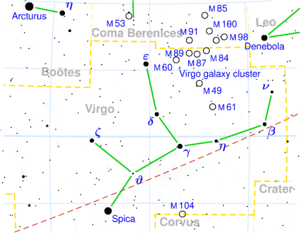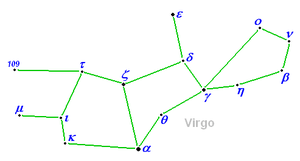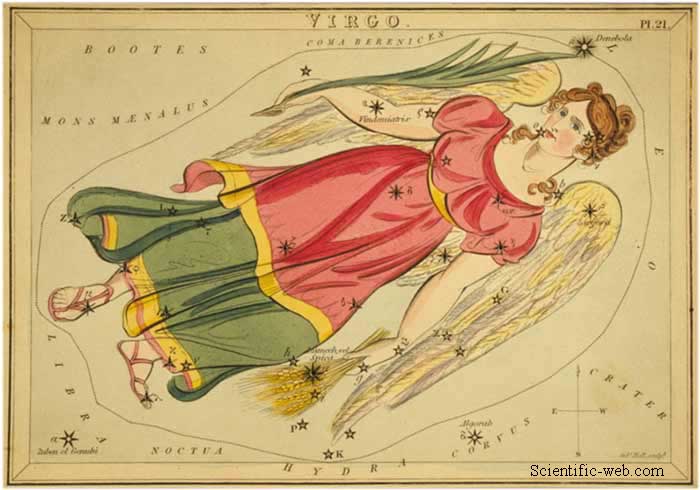|
|
Virgo ( Latin: virgin, symbol , Unicode ♍) is a constellation of the zodiac. Lying between Leo to the west and the Libra to the east, it is one of the largest constellations in the sky. It can be easily found through its brightest star, Spica.
Virgo is often portrayed carrying two sheaves of wheat, one of which is marked by the bright star Spica. Spica makes it easy to locate Virgo, as it can be found by following the curve of the Big Dipper to Arcturus in Boötes and continuing from there in the same curve ("follow the arc to Arcturus and speed on to Spica"). Other bright stars in Virgo include β Virginis (Zavijava), γ Vir (Porrima), δ Virginis (Auva) and ε Virginis (Vindemiatrix). Other fainter stars that were also given names are ζ Virginis (Heze), η Virginis (Zaniah), ι Virginis (Syrma) and μ Virginis (Rijl al Awwa). The star 70 Virginis is one of the first known extrasolar planetary system with one confirmed planet 7.5 times the mass of Jupiter. Due to the effects of precession, the First Point of Libra, (also known as the autumn equinox point) lies within the boundaries of Virgo very close to β Virginis. This is one of the two points in the sky where the celestial equator crosses the ecliptic (the other being the First Point of Aries, now in the constellation of Pisces.) This point will pass into the neighbouring constellation of Leo around the year 2440.
Notable deep sky objects Because of the presence of a galaxy cluster (consequently called the Virgo cluster) within its borders 5° to 10° west of ε Vir (Vindemiatrix), this constellation is especially rich in galaxies. Some examples are Messier 49 (elliptical), Messier 58 (spiral), Messier 59 (elliptical), Messier 60 (elliptical), Messier 61 (spiral), Messier 84 (lenticular), Messier 86 (lenticular), Messier 87 (elliptical and a famous radio source), Messier 89 (elliptical) and Messier 90 (spiral). A noted galaxy that is not part of the cluster is the Sombrero Galaxy (M104), an unusual spiral galaxy. It is located about 10° due west of Spica. The most prominent star in Virgo is Spica (α Vir), which was sometimes considered to represent an ear of wheat in Virgo's hand. Spica makes it easy to locate Virgo, as it can be found by following the curve of the Big Dipper to Arcturus in Boötes and continuing from there in the same curve ("follow the arc to Arcturus and speed on to Spica"). Mythology Who exactly Virgo was considered to represent is uncertain; in history, it has been associated with nearly every prominent goddess, including Ishtar, Isis, Cybele, and Athena, as well as with Mary the Mother of Jesus. Virgo may also feature, along with Ursa Major, and Ursa Minor, as part of the source of the myth of Callisto, either as Callisto herself, or as Hera. Persephone (who in some mythologies, notably the Eleusinian Mysteries, was considered to be a form of Demeter) is often mentioned as well, Virgo being visible mainly in the spring months when she was believed to have risen from the underworld. According to one interpretation, the constellation depicts Astraea, the virgin daughter of the god Zeus and the goddess Themis. Astraea was known as the goddess of justice, and was identified as this constellation due to the presence of the scales of justice Libra nearby, and supposedly ruled the world at one point with her wise ways until mankind became so callous she returned to the skies disgusted. Astrology In western astrology, the Sun is in the sign of Virgo from August 23 to September 22. Graphic visualization The stars of the constellation Virgo can be connected in an alternative way, which graphically shows the virgin lying down in a supine position.[1] The stars γ Vir, η Vir, β Vir, ν Vir, and ο Vir form the virgin's head. The stars γ Vir, δ Vir, ζ Vir, α Vir (Spica), and θ Vir form the virgin's blouse. The stars α Vir, ζ Vir, τ Vir, ι Vir, and κ Vir form the virgin's skirt. The stars 109 Vir and μ Vir represent the Virgin's feet, and the star ε Vir represents the virgin's hand.
Citations 1. ^ H. A. Rey, The Stars — A New Way To See Them. Enlarged World-Wide Edition. Houghton Mifflin, Boston, 1997. ISBN 0-395-24830-2. References * Ian Ridpath and Wil Tirion (2007). Stars and Planets Guide Links
Retrieved from "http://en.wikipedia.org/"
|
|
||||||||||||||||||||||||||||||||||||||||||||||||||||




